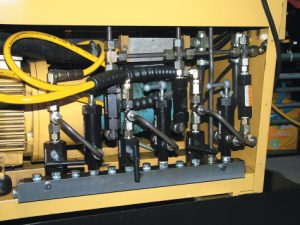Directional control valves are the workhorses heavily relied upon in the worlds of hydraulic circuits and machinery as well as pneumatic systems because of the way they allow fluids to flow into specific pathways from one or multiple sources. The most basic configuration is a spool inside a cylinder where the movement of the spool is what permits or restricts the flow of fluids through it. An actuating force must be applied to operate the valve and move it from normal (or neutral) position to working position. More complex control valves can have more than two basic positions by have multiple working positions.
Types of Directional Control Valves
Directional control valves are classified according to their various characteristics, such as the number of ports (external openings allowing fluid to enter and leave the valve), number of positions, actuating method used, the type of spool, the fluid path, and so on as follows:- Fluid Path: Check valves (allows flow in one direction only actuated by low-pressure input flow, blocking flow in the opposite direction), shuttle valves (allow for switching back and for the between two flow sources into a one-branch circuit, where one source is often just a backup for the other), two-way valves, three-way valves, four-way valves.
- Positions: There are typically two or three positions – neutral/normal and one or two working positions.
- Ports: The number of openings through which fluid can flow into and out of the valve.
- Actuation: How the valve is moved from one position to another, including manual (moving a handle, pushing a button, stepping on a foot pedal), mechanical (cam and rollers), pilot signal (hydraulic or pneumatic) or solenoid (energizing the solenoid or electric coil creates a magnetic field against the armature to push the spool into position.
- Spool: The type of spool can rotary (typically with manual actuation) such that the spool is rotated into a working position or sliding such that the spool is slid into a position to align its various chambers with the ports.
Functionality of Directional Control Valves
Out in the field these devices are often nicknamed “bang-bang valves.” These valves can shift from fully open to fully closed in an instant, which can cause “fluid hammer” or a banging noise. Sometimes they’re also called “discrete valves” because they shift from one discrete position to another or “switch valves” because they switch the flow by stopping it, starting or changing its direction. A number of combinations are possible in terms of the mix of ports and positions of different directional control valves. One example is a 4/3 or 4-ports 3-position valve. In the US it would be called a 4-way valve, but international standards use the word “port.” One of the ports would be for receiving a pressurized fluid from a pump, another would route fluid back to the reservoir or exhaust system (for pneumatic systems), and the remaining two ports would be for routing fluid to and from the actuator. In terms of the three positions, neutral would mean all ports are blocked and there is no flow of fluids. The remaining two working positions allow for the flow of liquids in the right directions to reach various components.Industries that Use Directional Control Valves
Using directional control valves is absolutely essential to any industry that relies on hydraulic circuits, machinery and equipment, which covers a dizzying array of application. Anything with a motor is going to use directional control valves, so they figure prominently in the automotive industry in every vehicle transmission you can think of, including automatic transmissions (AT), automated manual transmissions (AMT), continuous variable automatic transmissions (CVT), double-clutch transmissions (DCT) and the control of automated clutch actuations in hybrid drives. It’s hard to think of anything “industrial” that doesn’t make use of directional control valves – die casting and foundry, machine tooling, marine/offshore, press, primary metals, plastics, pulp and paper, test equipment and simulation, turbine control (wind, steam, water), wood processing and much, much more.Importance of Sourcing Directional Control Valves
Given how widely used directional control valves are across vastly different industries and applications, there are innumerable choices of valves from many different manufacturers. It makes sense to turn to a manufacturer that specializes in valves for your specific application. Metro Hydraulics designs and manufactures hydraulic valves for the agricultural, construction, turf and light industrial equipment markets. Valve types include 1, 2 and 3 spool directional control valves; two-position selector valves, lock valves, check valves, restrictor and relief valves all in a variety of sizes. If our standard valves don’t quite match up to what you need, we’ll gladly customize a design to meet your specifications.At Metro Hydraulic, we’ve been engineering the design, manufacturing and marketing of directional control valves for more than five decades. Contact Metro to request a quote today!

 Search
Search














3/2 directional control hydraulic valve with push button operated is available or not?
because i have seen in internet this type of valve is available only on pneumatic.